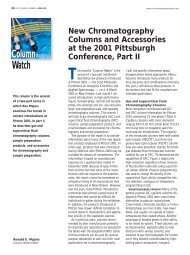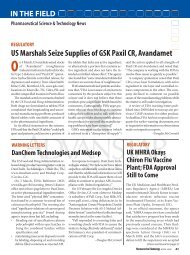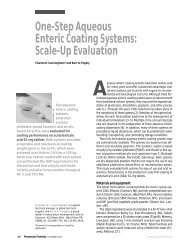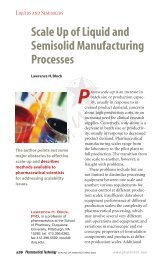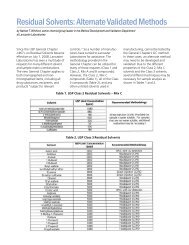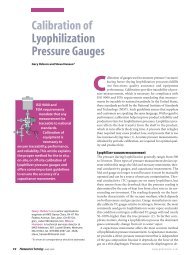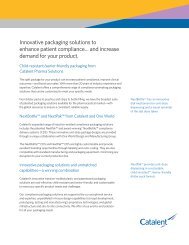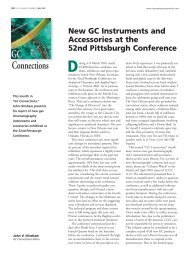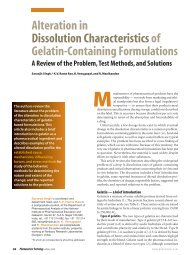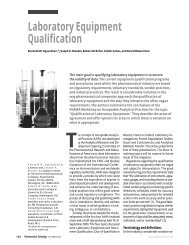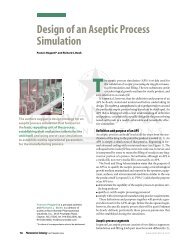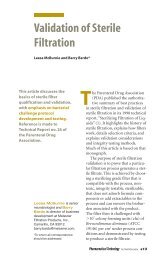Nanostructured Lipid Carriers - Pharmaceutical Technology
Nanostructured Lipid Carriers - Pharmaceutical Technology
Nanostructured Lipid Carriers - Pharmaceutical Technology
You also want an ePaper? Increase the reach of your titles
YUMPU automatically turns print PDFs into web optimized ePapers that Google loves.
<strong>Nanostructured</strong> <strong>Lipid</strong> <strong>Carriers</strong>:<br />
A Novel Generation of Solid <strong>Lipid</strong><br />
Drug <strong>Carriers</strong><br />
<strong>Nanostructured</strong> lipid carriers are a new type of delivery system offering improved<br />
performance in terms of drug loading and long-term stability with the ability to form<br />
highly concentrated dispersions.<br />
Polymeric nanoparticles have been intensely<br />
investigated since their introduction by Speiser<br />
and co-workers in the mid-seventies. Despite their<br />
interesting properties, not many products made it to<br />
market because of the presence of solvent residues<br />
left over from production, the cytotoxicity of the<br />
polymers, and the lack of low-cost, qualified largescale<br />
production units yielding a product of a quality<br />
acceptable by the regulatory authorities. As an<br />
alternative, solid lipid nanoparticles (SLNs) were<br />
developed in 1991 (Figure 1), 1 a technology now<br />
owned by the drug delivery company SkyePharma.<br />
The matrix is a blend of solid lipids. SLN<br />
formulations that have been developed, for example,<br />
for the oral delivery of cyclosporine<br />
(Pharmatec/Eurand, Milan) 2,3 and the intravenous<br />
delivery of Paclitaxel. Vectorpharma/Trieste followed<br />
a similar route by developing SLNs from<br />
microemulsions. 4,5<br />
A new generation of nanostructured lipid carriers<br />
(NLCs) consisting of a lipid matrix with a special<br />
nanostructure has been developed. 6–8 This<br />
nanostructure improves drug loading and firmly<br />
incorporates the drug during storage.These NLCs can<br />
be produced by high-pressure homogenization and the<br />
process can be modified to yield lipid particle<br />
dispersions with solid contents from 30–80%.<br />
Types of NLC<br />
It is well known from the study of suppositories that<br />
highly ordered crystalline lipid matrices will lead to<br />
drug expulsion. <strong>Lipid</strong> nanoparticles and microparticles<br />
made from blends of solid lipids can experience<br />
this, especially when nanoparticles are prepared<br />
from highly purified lipids, for example, tristearin. 9<br />
The formation of highly ordered i or modifications,<br />
particularly during storage, leaves little space<br />
for drug molecules, and the expulsion of drugs leads<br />
Magdalene Radtke<br />
is a research scientist at<br />
PharmaSol GmbH, Germany.<br />
Eliana B. Souto<br />
is a research scientist and<br />
Rainer H. Müller<br />
is a professor both at Freie<br />
Universität Berlin, Germany.<br />
www.ptemagazine.com<br />
I<br />
1
NANOSTRUCTURED LIPID CARRIERS<br />
Figure 1 Atomic force microscopy (AFM) graph of lipid nanoparticles.<br />
800m<br />
400m<br />
0m<br />
0m<br />
to drug crystals in suspensions and<br />
solid dosage forms. To avoid this<br />
problem, the particles should have a<br />
controlled nanostructure that offers<br />
enough space to accommodate the<br />
drug. Four different approaches were<br />
taken for an optimized nanostructure<br />
of NLCs.<br />
In type I, solid lipids and liquid<br />
lipids (oils) are blended. The difference<br />
in the structures of the lipids<br />
and special requirements in the crystallization<br />
process lead to a highly<br />
disordered, imperfect lipid matrix<br />
structure offering space for drug<br />
molecules and amorphous clusters of<br />
drugs (Figure 2, I).<br />
In general, drug solubility is higher<br />
in liquid lipids than in solid lipids.<br />
Based on this, particles were produced<br />
with a high content of liquid<br />
lipids (oils). During the production<br />
process, the liquid lipid particles<br />
400m<br />
(nanoemulsions) are cooled from the<br />
molten state to room temperature to<br />
crystallize and form solid particles.<br />
At high oil concentrations a miscibility<br />
gap of the two lipids (solid lipid<br />
plus oil) occurs during the cooling<br />
phase, leading to phase separation,<br />
that means precipitation of tiny oily<br />
nanocompartments (Figure 2, II). In<br />
this multiple oil/fat/water, type II<br />
drug can be accommodated in the<br />
solid, but at increased solubility in<br />
the oily parts of the lipid matrix.<br />
In type III, lipids are mixed in a<br />
way that prevents them from crystallizing.<br />
The lipid matrix is solid, but in<br />
an amorphous state (Figure 2, III). 7<br />
The absence of crystallization avoids<br />
drug expulsion by crystallization.<br />
<strong>Lipid</strong> particles are preferentially<br />
suited to incorporate lipophillic<br />
drugs; hydrophilic drugs can only be<br />
incorporated at a low percentage<br />
Figure 2 Different types of NLC: I – highly imperfect matrix; II – multiple O/F/W type;<br />
III – non-crystalline amorphous NLC (versus SLN with high crystallinity).<br />
SLN<br />
(Solid lipid blend)<br />
drug<br />
Low oil<br />
NLC<br />
(Solid lipid + oil)<br />
High oil<br />
194.85 nm<br />
97.42 nm<br />
0 nm<br />
800m<br />
Amorphous<br />
I II III<br />
(however, this is still sufficient for<br />
highly potent peptides and proteins).<br />
In a further variation of the lipid<br />
matrix, water-soluble drugs were<br />
conjugated with a lipid, thus forming<br />
a water-insoluble lipidic conjugate.<br />
The lipid conjugate powder was<br />
melted and processed in the same<br />
way as the other types to yield a lipid<br />
drug conjugate (LDC) nanoparticle. 8<br />
Depending on the conjugate, this<br />
lipidic conjugate has a drug loading<br />
of up to 30–50% for water-soluble<br />
drugs. Conjugation is performed by<br />
salt formation or covalent linkage.<br />
Modulation of Drug Release<br />
Drug release from lipid particles<br />
occurs by diffusion and<br />
simultaneously by lipid particle<br />
degradation in the body. In some<br />
cases it might be desirable to have a<br />
controlled fast release going beyond<br />
diffusion and degradation. Ideally this<br />
release should be triggered by an<br />
impulse when the particles are<br />
administered.<br />
NLCs accommodate the drug<br />
because of their highly unordered<br />
lipid structures. By applying the<br />
trigger impulse to the matrix to<br />
convert in a more ordered structure,<br />
such a desired burst drug release can<br />
be initiated. NLCs of certain<br />
structures can be triggered this way;<br />
for example, when applying the<br />
particles to the skin incorporated in a<br />
cream. Increase in temperature and<br />
water evaporation leads to an<br />
increase in drug release rate (Figure<br />
3). Based on these cyclosporine-lipid<br />
particles are under development to<br />
treat psoriasis. 10,11 The cream itself is<br />
saturated with cyclosporine, as well as<br />
a cyclosporine-loaded NLC contained<br />
in the cream. After application to the<br />
skin, accelerated release from the<br />
lipid particles should lead to a<br />
supersaturated system (similar to<br />
microemulsions, but without high<br />
surfactant concentration) leading to<br />
an improved penetration of<br />
cyclosporine into the skin.<br />
Long-Term Stability<br />
During long-term storage of dispersions,<br />
particle aggregation can occur.<br />
Aggregation and shell formation<br />
were reported for SLNs. 12 Single particles<br />
diffuse in the dispersion<br />
medium; collision of particles can lead<br />
to perikinetic flocculation (Figure 4a).<br />
2<br />
I<br />
PHARMACEUTICAL TECHNOLOGY EUROPE, 17(4) 45–50 (2005)
NANOSTRUCTURED LIPID CARRIERS<br />
In the highly concentrated NLC<br />
dispersions the particles form a<br />
‘pearl-like network’, thus the<br />
particles are in a fixed position and<br />
cannot undergo collision and<br />
perikinetic flocculation. After<br />
administration of the particles and<br />
dilution with fluids (gastrointestinal<br />
fluids, for example), the network is<br />
destroyed releasing single,<br />
nonaggregated particles (Figure 4b).<br />
<strong>Lipid</strong> particle dispersions were<br />
produced at identical surfactant concentration,<br />
but with low lipid content<br />
(below 30%, outside patent coverage)<br />
and with 35% lipid. The low<br />
particle dispersion aggregated during<br />
storage time, the gel-like NLC dispersion<br />
remained stable during<br />
storage and, after dilution, single particles<br />
were obtained showing no size<br />
increase. 13<br />
a dispersion contains 50 g of lipid and<br />
50 g of water. In the next step, 10 g of<br />
lipid is added, which is dispersed by<br />
high-speed stirring in the remaining<br />
50 g of water. This results in 110 g of<br />
dispersion containing 60 g of lipid<br />
(55%) and again 50 g of water. In the<br />
next step, another 10 g of lipid is dispersed<br />
in this 50 g of water phase and<br />
so on until a lipid content of 80% is<br />
reached.<br />
Large-scale production of NLC is<br />
easily possible. High-pressure<br />
homogenizers are available to<br />
process one ton and more per hour.<br />
There are also no regulatory hurdles<br />
because these machines are accepted<br />
in production lines for parenterals, in<br />
parenteral emulsions for nutrition,<br />
for example.<br />
Application Areas<br />
Oral administration of NLCs is<br />
definitely a very interesting and<br />
easy-to-realize area. The basic<br />
usefulness of lipid particles for oral<br />
delivery has been shown by the<br />
SLN-cyclosporine patents — NLCs<br />
have the potential to do an even<br />
better job. In addition, lipids<br />
promote the absorption of a range<br />
of drugs, also supporting the use of<br />
lipid particles for oral delivery. Of<br />
special interest for oral delivery are<br />
lipid–drug conjugate (LDC)<br />
nanoparticles providing highloading<br />
capacities for hydrophilic<br />
drugs. Primary drugs of interest are<br />
compounds undergoing chemical<br />
degradation in the gastrointestinal<br />
tract. NLCs can be incorporated<br />
Production of NLCs<br />
NLCs can be produced by various<br />
traditional dispersion techniques.<br />
The preferred production method is<br />
high-pressure homogenization. Up to<br />
approximately 60% solid content,<br />
high-pressure homogenization can<br />
be applied alone to achieve solid<br />
contents of, for example, 80% when<br />
the multistep process is applied.<br />
First the lipid phase is melted.Then<br />
the drug is dissolved in the molten<br />
lipid thereby, preparing a drugcontaining<br />
lipid melt.This melt is then<br />
dispersed in an aqueous surfactant<br />
solution heated at the same<br />
temperature, using a high-speed<br />
stirring.The obtained pre-emulsion is<br />
then homogenized using a piston-gap<br />
homogenizer. Small lab-scale batches<br />
of 40 mL are produced using a<br />
discontinuous LAB 40 (APV<br />
Homogenizer GmbH, Germany).<br />
Larger batches up to a 0.5 L dispersion<br />
are produced using a modified<br />
continuous LAB 40 homogenizer<br />
tower and the two product vessels<br />
possess temperature control jackets.<br />
The highly concentrated NLC dispersions<br />
are highly viscous, gel-like<br />
or pasty. These systems have no<br />
flowability — the difference to conventional<br />
emulsions and SLN dispersions<br />
is shown in Figure 5.<br />
To produce an 80% NLC dispersion,<br />
a multistep production process is<br />
applied. First, a 50% SLN dispersion<br />
is produced by high-pressure homogenization.<br />
One hundred grams of such<br />
Figure 3 Triggered drug release from NLC by initiating the conversion from a highly disordered<br />
lipid structure to more ordered stable modifications.<br />
NLC<br />
Type I/II<br />
Trigger impulse<br />
e.g. T; H 2 O<br />
Figure 4 Aggregation process in low concentrated dispersions (upper) and pearl-like network<br />
in NLC dispersions with stabilizing effect.<br />
Low lipid particle concentration<br />
(e.g. SLN)<br />
The NLC, pearl network<br />
storage stable<br />
Storage<br />
Application<br />
i.e. dilution<br />
(GIT, blood)<br />
Aggregates<br />
drug<br />
Finely dispersed nanoparticle<br />
www.ptemagazine.com<br />
I<br />
3
NANOSTRUCTURED LIPID CARRIERS<br />
into traditional dosage forms such<br />
as tablets and pellets using the NLC<br />
dispersion as granulation fluid or<br />
wetting liquid for the pellet mass.<br />
NLCs produced in oil or<br />
polyethylene glycol (PEG) 400 can<br />
be filled directly into soft gelatin<br />
capsules.<br />
The second easy-to-realize area is<br />
topical application. All the lipids<br />
and surfactants used in traditional<br />
pharmaceutical creams can be<br />
employed, thus leaving little<br />
regulatory hurdles. Data are<br />
available showing delivery<br />
advantages of lipid particles<br />
compared to normal creams and<br />
ointments. Because of the high<br />
consistency of NLC dispersions,<br />
they can be used as topical dosage<br />
forms without further processing.<br />
First lines in parenteral delivery<br />
are controlled release forms<br />
(subcutaneous or intramuscular, for<br />
example) and the intravenous<br />
route. LDC nanoparticles have<br />
proved particularly useful for<br />
targeting water-soluble drugs to<br />
the brain.<br />
Control Rel. Bioact. Mater. 28, 472–473<br />
(2001).<br />
11. M. Radtke and R.H Müller, Int. Symp.<br />
Control Rel. Bioact. Mater. 28, 470–471<br />
(2001).<br />
12. C. Freitas and R.H. Müller, Eur. J. Pharm.<br />
Biopharm. 47, 125–132 (1999).<br />
13. A. Lippacher, “<strong>Pharmaceutical</strong><br />
Characterization of Liquid and Semi-Soid<br />
SLN Dispersions for Topical<br />
Application,” Ph.D. Thesis, Free<br />
University of Berlin, Germany (2001). ■<br />
Perspectives<br />
NLCs can generally be applied<br />
where solid nanoparticles possess<br />
advantages for the delivery of drugs.<br />
Major application areas in pharmaceutics<br />
are topical drug delivery, oral<br />
and parenteral administration. They<br />
also have applications in cosmetics,<br />
food and agricultural products.<br />
References<br />
1. R.H. Müller and J.S. Lucks, European<br />
Patent 0605497 (1996).<br />
2. R.H. Müller, S.A, Runge and V. Ravelli,<br />
German patent application<br />
DE 19819273 A1 (1998).<br />
3. L. Penkler et al., extended patent on the<br />
basis of (2), PCT application<br />
PCT/EP99/02892 (1999).<br />
4. M.R. Gasco, Patent 5250236 (1993).<br />
5. L. Boltri et al., Proc. Int. Symp. Control.<br />
Release Bioact. Mater. 20, 346–347 (1993).<br />
6. R.H. Müller et al., German patent<br />
application 199 45 203.2 (2000).<br />
7. R.H. Müller et al., extended patent on the<br />
basis of (6), PCT application<br />
PCT/EP00/04112 (2000).<br />
8. R.H. Müller et al., PCT application<br />
PCT/EP00/04111 (2000).<br />
9. H. Bunjes, K. Westesen and M.H Koch,<br />
Int. J. Pharm. 129, 159–173 (1996).<br />
10. M. Radtke and R.H. Müller, Int. Symp.<br />
4<br />
I<br />
PHARMACEUTICAL TECHNOLOGY EUROPE, 17(4) 45–50 (2005)



